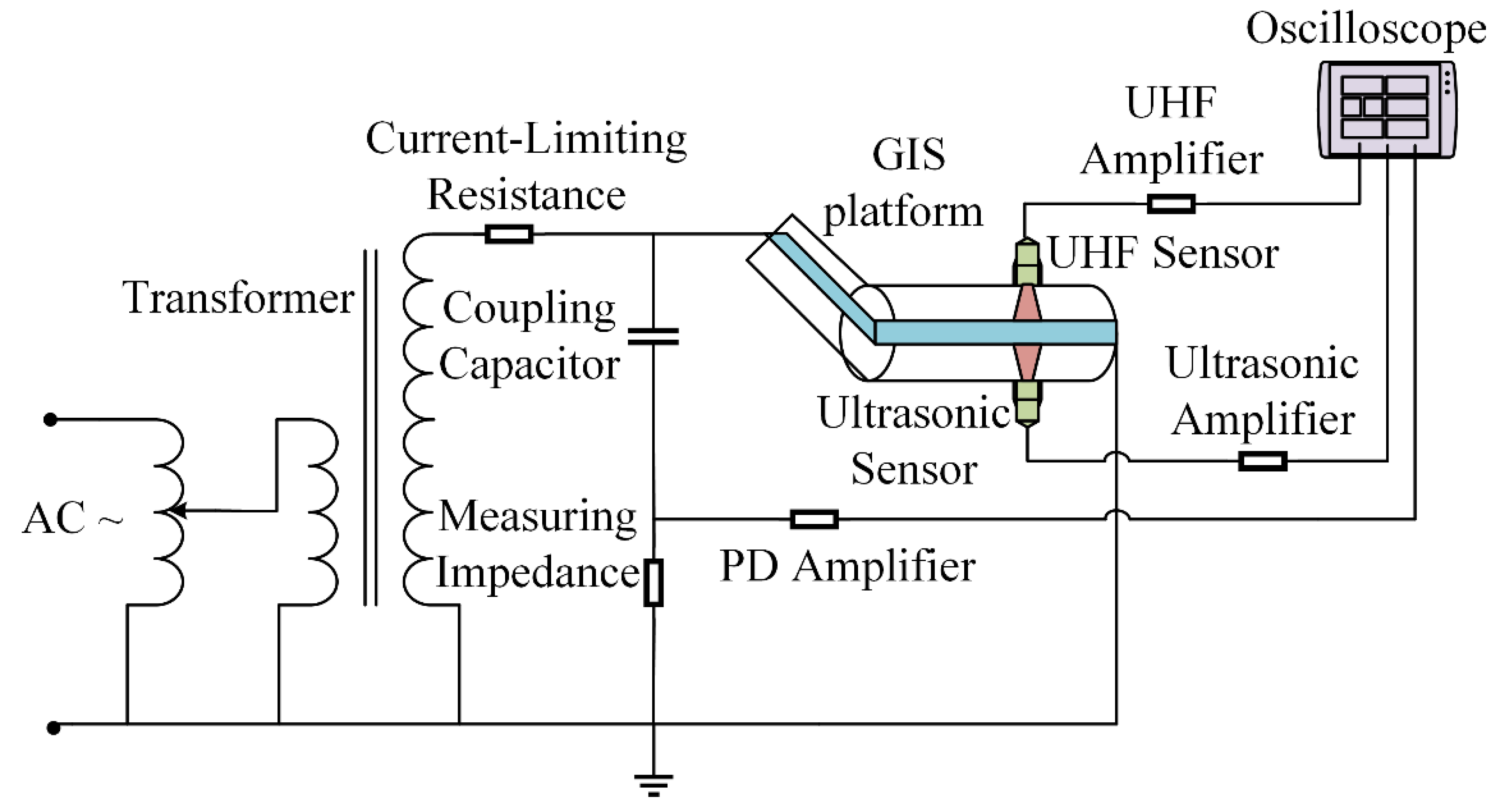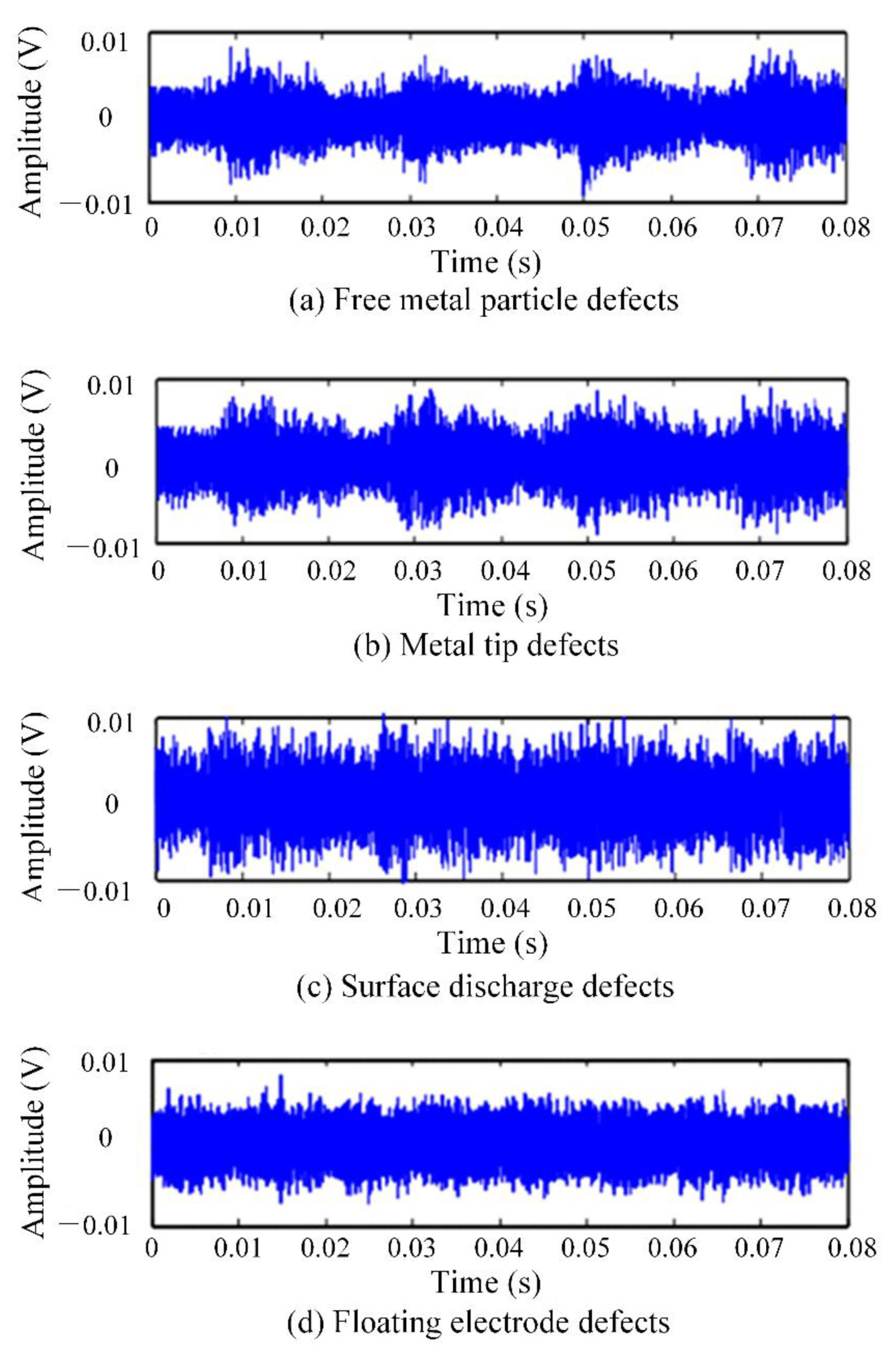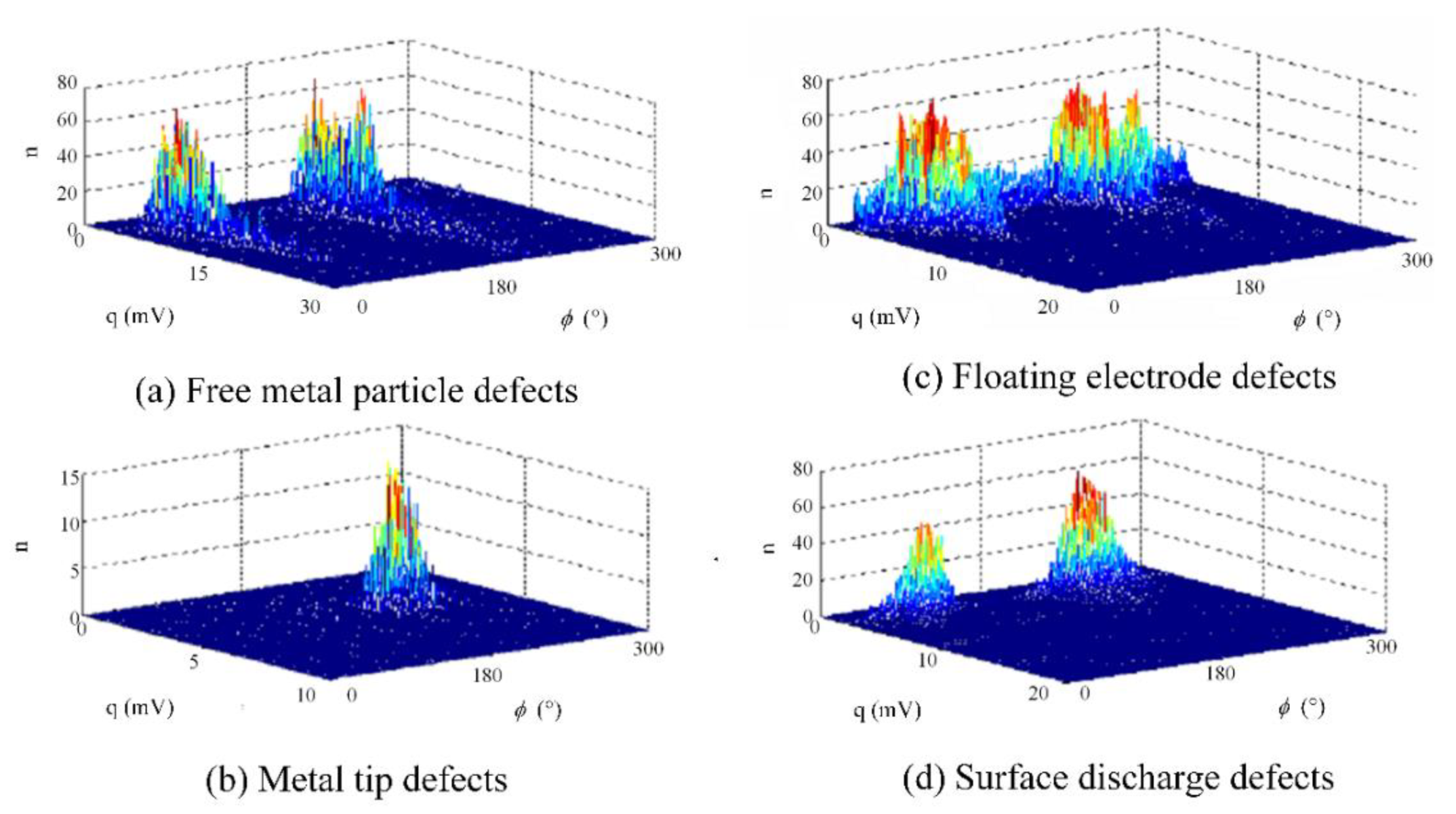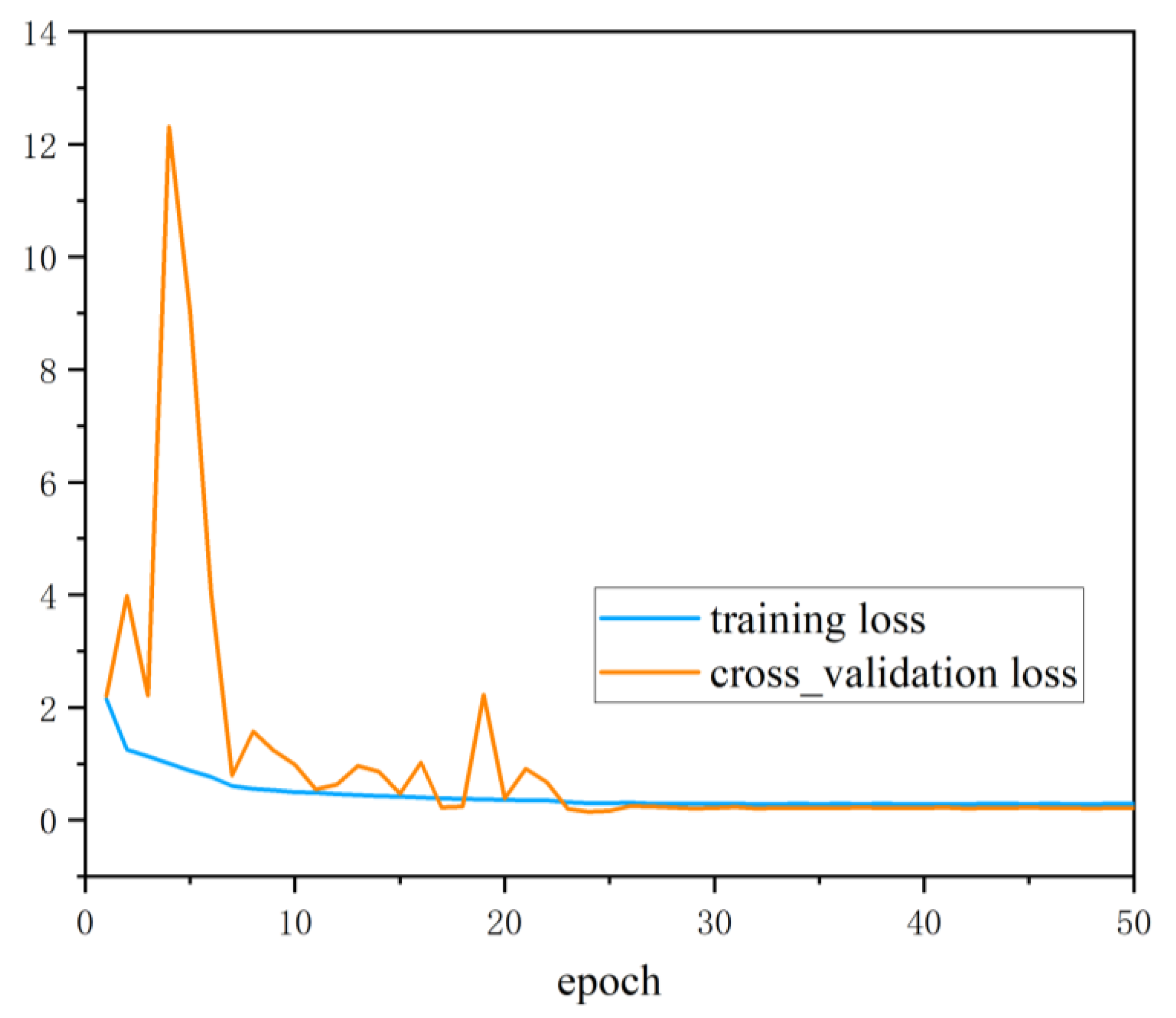A Novel Method for Pattern Recognition of GIS Partial Discharge via Multi-Information Ensemble Learning
Abstract
:1. Introduction
2. The Proposed Method
2.1. The Diagnostic Framework Based on Multi-Information Ensemble Learning
2.2. The Feature Extraction Based on Deep Residual CNN
2.3. Decision-Level Fusion Recognition Based on Ensemble Learning
3. Experimental Method
3.1. Method Theoretical Analysis
3.2. Experimental Platform and Data Acquisition
4. Results and Analysis
4.1. Experimental Setup
4.2. Analysis of Diagnosis Results
4.3. Result Comparison with Different Methods
5. Conclusions
Author Contributions
Funding
Data Availability Statement
Conflicts of Interest
References
- Khan, Q.; Refaat, S.S.; Abu-Rub, H.; Toliyat, H.A. Partial discharge detection and diagnosis in gas insulated switchgear: State of the art. IEEE Electr. Insul. M 2019, 35, 16–33. [Google Scholar] [CrossRef]
- Wang, Y.; Yan, J.; Sun, Q.; Li, J.; Yang, Z. A MobileNets convolutional neural network for GIS partial discharge pattern recognition in the ubiquitous power internet of things context: Optimization, comparison, and application. IEEE Access 2019, 7, 150226–150236. [Google Scholar] [CrossRef]
- Tian, J.; Song, H.; Sheng, G.; Jiang, X. Knowledge-Driven Recognition Methodology of Partial Discharge Patterns in GIS. IEEE Trans. Power Deliv. 2021. [Google Scholar] [CrossRef]
- Wang, Y.; Yan, J.; Yang, Z.; Jing, Q.; Qi, Z.; Wang, J.; Geng, Y. A Domain Adaptive Deep Transfer Learning Method for Gas-Insulated Switchgear Partial Discharge Diagnosis. IEEE Trans. Power Deliv. 2021. [Google Scholar] [CrossRef]
- Liu, T.; Yan, J.; Wang, Y.; Xu, Y.; Zhao, Y. GIS partial discharge pattern recognition based on a novel convolutional neural networks and long short-term memory. Entropy 2021, 23, 774. [Google Scholar] [CrossRef]
- Wang, Y.; Yan, J.; Yang, Z.; Zhao, Y.; Liu, T. Optimizing GIS partial discharge pattern recognition in the ubiquitous power internet of things context: A MixNet deep learning model. Int. J. Electr. Power Energy Syst. 2021, 125, 106484. [Google Scholar] [CrossRef]
- Tuyet-Doan, V.N.; Nguyen, T.T.; Nguyen, M.T.; Lee, J.H.; Kim, Y.H. Self-attention network for partial-discharge diagnosis in gas-insulated switchgear. Energies 2020, 13, 2102. [Google Scholar] [CrossRef] [Green Version]
- Ilkhechi, H.D.; Samimi, M.H. Applications of the acoustic method in partial discharge measurement: A review. IEEE Trans. Dielectr. Electr. Insul. 2021, 28, 42–51. [Google Scholar] [CrossRef]
- Zhou, K.; Oh, S.K.; Qiu, J. Design of Ensemble Fuzzy-RBF Neural Networks Based on Feature Extraction and Multi-feature Fusion for GIS Partial Discharge Recognition and Classification. J. Electr. Eng. Technol. 2022, 17, 513–532. [Google Scholar] [CrossRef]
- Wu, Y.J.; Ding, D.; Wang, Y.; Zhou, C.; Lu, H.; Zhang, X. Defect Recognition and Condition Assessment of Epoxy Insulators in Gas Insulated Switchgear Based on Multi-information Fusion. Measurement 2022, 190, 110701. [Google Scholar] [CrossRef]
- Yao, Q.; Wu, S.; Miao, Y.; Tang, J.; Zhang, S.; Zeng, F. GIS insulation state evaluation based on multi-source information Fusion. In Proceedings of the International Symposium on High Voltage Engineering, Budapest, Hungary, 26–30 August 2019; pp. 406–416. [Google Scholar]
- Li, L.; Tang, J.; Liu, Y. Partial discharge recognition in gas insulated switchgear based on multi-information fusion. IEEE Trans. Dielectr. Electr. Insul. 2015, 22, 1080–1087. [Google Scholar] [CrossRef]
- Li, S.; Liu, G.; Tang, X.; Lu, J.; Hu, J. An ensemble deep convolutional neural network model with improved DS evidence fusion for bearing fault diagnosis. Sensors 2017, 17, 1729. [Google Scholar] [CrossRef] [PubMed] [Green Version]
- Zhang, W.; Li, X.; Ding, Q. Deep residual learning-based fault diagnosis method for rotating machinery. ISA Trans. 2019, 95, 295–305. [Google Scholar] [CrossRef] [PubMed]
- Liu, Z.M. Multi-feature fusion for specific emitter identification via deep ensemble learning. Digit. Signal. Process. 2021, 110, 102939. [Google Scholar] [CrossRef]
- Darwish, A.; Refaat, S.S.; Abu-Rub, H.; Toliyat, H.A. PD signal propagation in GIS: Ultra-high frequency detection-based modeling. IEEE Sens. J. 2020, 20, 9417–9426. [Google Scholar] [CrossRef]
- Ge, X.; Ji, H.; Cui, X.; Li, C. Movement behavior and partial discharge of the single metallic particle in GIS at operated voltage. IEEE Trans. Plasma Sci. 2019, 47, 4319–4328. [Google Scholar] [CrossRef]
- Song, H.; Dai, J.; Sheng, G.; Jiang, X. GIS partial discharge pattern recognition via deep convolutional neural network under complex data source. IEEE Trans. Dielectr. Electr. Insul. 2018, 25, 678–685. [Google Scholar] [CrossRef]
- Wang, Y.; Yan, J.; Yang, Z.; Liu, T.; Zhao, Y. Partial discharge pattern recognition of gas-insulated switchgear via a light-scale convolutional neural network. Energies 2019, 12, 4674. [Google Scholar] [CrossRef] [Green Version]
- Tang, J.; Zhou, Q.; Tang, M.; Xie, Y. Study on mathematical model for VHF partial discharge of typical insulated defects in GIS. IEEE Trans. Dielectr. Electr. Insul. 2007, 14, 30–38. [Google Scholar] [CrossRef]
- Raymond, W.J.K.; Illias, H.A. High noise tolerance feature extraction for partial discharge classification in XLPE cable joints. IEEE Trans. Dielectr. Electr. Insul. 2017, 24, 66–74. [Google Scholar] [CrossRef]
- Raymond, W.J.K.; Xin, C.W.; Kin, L.W. Noise invariant partial discharge classification based on convolutional neural network. Measurement 2021, 177, 109220. [Google Scholar] [CrossRef]
- Ling, Y.; Bai, D.; Wang, M.; Gong, X.; Gu, C. SVM-based partial discharge pattern classification for GIS. In Proceedings of the Journal of Physics: Conference Series, Shenzhen, China, 17–19 November 2018; Volume 960, p. 012051. [Google Scholar]
- Barrios, S.; Buldain, D.; Comech, M.P. Partial discharge classification using deep learning methods—Survey of recent progress. Energies 2019, 12, 2485. [Google Scholar] [CrossRef] [Green Version]









| Dataset Type | Target Class | Output Class | Overall Accuracy (%) | |||
|---|---|---|---|---|---|---|
| M | N | O | P | |||
| UHF | M | 173 | 0 | 17 | 10 | 91.625 |
| N | 0 | 200 | 0 | 0 | ||
| O | 12 | 0 | 171 | 17 | ||
| P | 3 | 0 | 8 | 189 | ||
| Ultrasonic | M | 189 | 7 | 3 | 1 | 88.375 |
| N | 17 | 167 | 12 | 4 | ||
| O | 2 | 2 | 181 | 15 | ||
| P | 4 | 7 | 19 | 170 | ||
| UHF + Ultrasonic | M | 198 | 2 | 0 | 0 | 97.500 |
| N | 0 | 200 | 0 | 0 | ||
| O | 4 | 0 | 189 | 7 | ||
| P | 3 | 0 | 4 | 193 | ||
| Ref. | Dataset Type | PD Fault Feature | Classifiers | Accuracy |
|---|---|---|---|---|
| Tuyet et al. [7] | UHF | phase resolved PD images | Long short-term memory + CNN | 93.625% |
| Ling et al. [23] | UHF | statistical features of phase resolved PD | Support vector machine (SVM) | 86.750% |
| Barrios et al. [24] | UHF | phase resolved PD data | Autoencoder | 90.125% |
| Li L et al. [12] | phase resolved PD + time resolved PD | statistical features of time and frequency domain | BPNN + D-S evidence theory fusion | 94.375% |
| Wu Y et al. [10] | phase resolved PD + time resolved PD + ultrasonic | grayscale image features, statistical features, et al. | SVM + D-S evidence theory fusion | 95.125% |
| Proposed | UHF + ultrasonic | 2D images | Deep CNN + D-S evidence theory fusion | 95.250% |
| Proposed | UHF + ultrasonic | statistical features | BPNN + D-S evidence theory fusion | 93.750% |
| Proposed | UHF + ultrasonic | 2D images | Deep residual CNN+ ensemble learning | 97.500% |
Publisher’s Note: MDPI stays neutral with regard to jurisdictional claims in published maps and institutional affiliations. |
© 2022 by the authors. Licensee MDPI, Basel, Switzerland. This article is an open access article distributed under the terms and conditions of the Creative Commons Attribution (CC BY) license (https://creativecommons.org/licenses/by/4.0/).
Share and Cite
Jing, Q.; Yan, J.; Lu, L.; Xu, Y.; Yang, F. A Novel Method for Pattern Recognition of GIS Partial Discharge via Multi-Information Ensemble Learning. Entropy 2022, 24, 954. https://doi.org/10.3390/e24070954
Jing Q, Yan J, Lu L, Xu Y, Yang F. A Novel Method for Pattern Recognition of GIS Partial Discharge via Multi-Information Ensemble Learning. Entropy. 2022; 24(7):954. https://doi.org/10.3390/e24070954
Chicago/Turabian StyleJing, Qianzhen, Jing Yan, Lei Lu, Yifan Xu, and Fan Yang. 2022. "A Novel Method for Pattern Recognition of GIS Partial Discharge via Multi-Information Ensemble Learning" Entropy 24, no. 7: 954. https://doi.org/10.3390/e24070954






